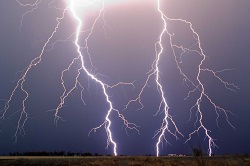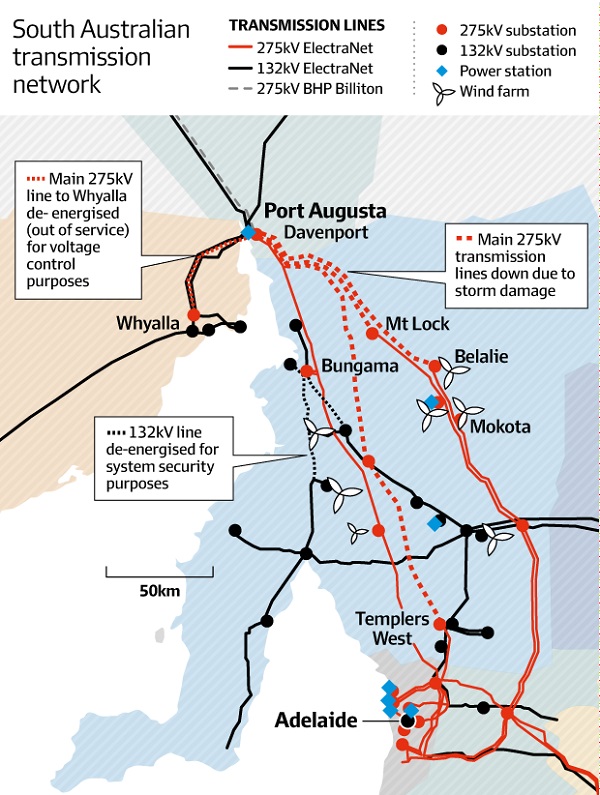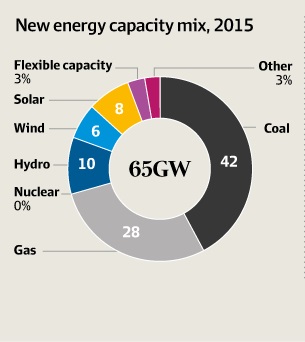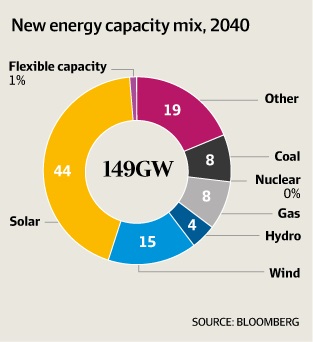 One of the more eye-catching comments on the SA blackouts was from AGL Energy’s CEO Andy Vesey telling the All Energy conference in Melbourne that a secure power system would be rooftop solar and batteries in a distributed power system with power being generated at the point of consumption. He also said that politicians were blaming the South Australian blackout on renewable energy because technological disruption was confounding their “mental models”.
One of the more eye-catching comments on the SA blackouts was from AGL Energy’s CEO Andy Vesey telling the All Energy conference in Melbourne that a secure power system would be rooftop solar and batteries in a distributed power system with power being generated at the point of consumption. He also said that politicians were blaming the South Australian blackout on renewable energy because technological disruption was confounding their “mental models”.
Greg Hunt, a man clearly in a muddle, went in hard, as reported by Giles Parkinson at RenewEconomy:
- In an opinion piece written for the Australian Financial Review, and reported as the front page lead “SA blackout could have been avoided” – Hunt claimed that a coal-fired generator could have kept the lights on in Olympic Dam and Whyalla and avoided much of the damage, and he also chastised the states for chasing unrealistic targets.
On targets, In Paris last December he said he’d encouraged the states to do something extra if they wanted to, and praised the reverse auctions conducted by the ACT. Now he blames them for responding to his encouragement.
On the blackout, AGL and the Australian Energy Market Operator both said the blackout would have happened anyway no matter what was hanging off the wires. Experts agree. Supply and demand need to be kept in balance, or bad things happen. When the pylons went down, the whole SA system shut down. Basically more power was dragged from the Heywood interconnector than it had the capacity to supply, so it shut down in a space of around 40 seconds.
Hugh Saddler looks at the AEMO report, put out last Wednesday. The vulnerability had been assessed in a regular AEMO report in August, but the risk was deemed a “non-credible contingency event”. Unfortunately the non-credible happened.
For us in SE Queensland this is a garden variety blackout in terms of duration. The extent was unusual, but the storm front was big and moved across the whole ‘settled area’ of the state. SES here last week were exhorting people to get together a kit to last for three days in preparation for the storm season. In SA after the blackout power was cranked up from the Victorian interconnector because the gas power available in SA didn’t work at first. However homes began to be connected within three hours.
It seems that the loss of 17% of total demand from northern wind at the time triggered the failure, but if Port Augusta coal had been operating, the loss could have been even greater. The exact sequence awaits the final AEMO incident report, but AGL which owns wind farms near Hallett and Burra (as well as the biggest portfolio of coal-fired generators in the country) say the wind was working until the lines went down, but Barnaby and the media would know best.
The AFR reports that when the Northern Power Station in Port Augusta shut down in May ElectraNet, South Australia’s transmission monopoly, had to install a switch to cut off the state’s north – including BHP Billiton’s Olympic Dam mine and Oz Minerals’ Prominent Hill mine – to protect the grid after Northern’s closure because of possible “voltage collapses”.
So the coal power station did have a voltage stabilising role. Electranet had addressed this issue in a report in August, and had estimated that a permanent fix would cost $30 to $100 million. In the event, three of the four lines to the north were cut, which no system could have coped with. Here’s a map of the network:

It’s possible, though, that had Northern been open power could have been restored earlier to Arrium’s steel plant at Whyalla and BHP Billiton’s Olympic Dam project. Continued high winds have delayed restoration of the network. Vesey says, however, the world has moved on as it must.
The SA blackouts moved Federal energy and climate minister Josh Frydenberg to call state ministers together under the COAG banner on Friday. The outcome was to task Chief Scientist Alan Finkel to review the National Electricity Market and provide a blueprint for energy security across the grid:
- Dr Finkel’s panel is charged with devising a plan to ensure future energy security, affordability and sustainability as more renewable energy comes into the electricity system and more coal-fired power stations close.
States are sticking to their targets, however, saying that the Commonwealth is not doing enough to meet its Paris commitments.
In a real sense the SA events and the COAG meeting was a wake-up call, but principally for Frydenberg and his feral ministerial colleagues. Just about everyone else was already working on the problem, or rather, working towards the necessary transitional arrangements.
- The meeting heard from experts from the Australian Energy Market Operator on the South Australian blackout and by AEMO, the Australian Energy Markets Commission and CSIRO on their progress in studies of progress in battery technology and how the National Electricity Grid needs to change to accommodate more renewable energy, batteries and other technology without suffering the instability that has hit South Australia.
Their interest reflects that renewables in Australia are on the move. Here are some of the other things happening:
- Mr Vesey said” AGL and the NSW government would announce a scheme to help low-income households enjoy the benefits of solar and batteries.”
- SA Power Networks are undertaking a 100-home trial in Adelaide of supplying discounted batteries with solar storage. During the SA blackout the Hart family “cooked, watched telly, turned on the lights on the ground floor of their house, washed clothes and dried them in their energy-efficient condenser dryer. When the power came on more than five hours later, Hart checked the battery. They’d used a fifth of its capacity.”
- Leading UK-based solar farm developer, Eco Energy World Australia, has received approval for its first 140MW solar farm in Queensland, and intends to bypass Australia’s major electricity utilities in order to sell the output from its growing portfolio of projects to the spot market. They have 1GW of large-scale solar projects, all in Queensland. They are taking advantage of the RET renewable energy certificates, which are now selling at more than $80/MWh.
- Western Australia’s regional utility Horizon Power has launched a project to deliver what it claims will be Australia’s largest solar and storage-based microgrid once complete in early 2018.
- Australian battery storage developer Redflow is off to a flying start for its new ZCell product, saying it has already received a $600,000 order from a Melbourne-based energy system installer, Standard Solar.
- As I have already reported, Brisbane energy group Lyon Solar has enlisted Japanese giant Mitsubishi Corporation to bankroll a $2 billion solar and battery power program that could help prevent blackouts like the one that hit SA. They plan to build 1000 megawatts of large-scale solar power and storage batteries across Australia by 2020 in a world-leading program that could spawn a local battery assembly industry.
- World-first solar tower powered tomato farm opens in Port Augusta worth $200 million. The Sundrop tomato farm – which has generated jobs for around 175 people – is the first commercial-scale facility of its calibre in the world, using sunlight and seawater to grow 15 million kg of truss tomatoes a year that will be sold exclusively through Coles supermarkets via a 10-year offtake agreement. The greenhouses will also produce more than 450,000m3 of freshwater per year – equivalent to 180 Olympic size swimming pools – and displace the use of more than 2 million litres of diesel per year.
- The All Energy conference take-out included the prospect of 10,000 residential storage systems installed in 2017, but the big mover would be utility-scale solar.
Those are bits of news readily to hand. However, the AEMO, the AEMC and the CSIRO must have appreciated the chance to meet with all those ministers with minds focussed on energy futures. Ministers were told:
- Bloomberg New Energy Finance projects that by 2040, 35 per cent of generation capacity will be “behind the meter” in people’s homes and business premises, with 38 gigawatts of solar panels – more than half the capacity of the entire energy system today – and 15GW in batteries.
Also:
- Rooftop and grid scale solar generation will be 44 per cent of total system capacity – up from 8 per cent today. Wind capacity will grow more slowly – to 15 per cent of capacity from 6 per cent today – as solar costs fall quickly. Coal and gas-fired generation will be 16 per cent of capacity, down from 70 per cent today.
Here’s the energy mix for 2015:

And here we go for 2040:

The cost is estimated at a mere $116 billion in new generation alone.
It’s a fair bet that Frydenberg was on the biggest learning curve. Problem is that when all that is done we’ll have heaps of power and a stable grid, but emissions will only fall by 23 per cent.

I don’t know whether it still makes sense to have solar towers with molten salt (or graphite) heat storage with back-up heat storage heaters using gas, oil or bio-fuels. Such an installation can be used for base or peaking power generation. (Not sure how cost competitve a solar tower would be.
There has been a campaign based on the BZE “Repower Pt Augusta” report arguing the case for a solar tower based installation at Pt Augusta to at least partially replace the coal fired power station that has been recently shut down. Might have helped during the last few weeks as well as reducing the need for high cost gas power.
Thanks for that excellent compilation, Brian. It pretty well backs up most of what the Blogosphere predicted.
I think the saved 23% figure will be higher once electric vehicles enter the energy economy in a significant way. To date only Toyota and Mitsubishi have taken up the challenge with most of the other importers believing that Australians only want gas guzzling heavy metal for their wheels. Now that is a curious comment to make while I am in Chicago where everything is big. In fact it occurred to me that in some parts of America people are shrinking in relation to their assets.
http://3.bp.blogspot.com/-8w7UQ0_nycQ/VHJEhorDBYI/AAAAAAAAZtc/nvbjTHZ6yf8/s1600/IMG_20141120_101159.jpg
My expectation is though that as the transition to renewable energy sources gains pace it width of field also increases in surprising ways. One totally unpredicted example is the use of drones for aerial video footage, successful to the extent that expensive conventional aircraft are no longer necessary for this task, ie huge fuel consumption replaced by minute amounts of electrical energy.
John, it seems the future is with solar, in the main, on the basis of availability in australia and cost. If it gets aywhere near the 44% forecast one would think it would need to supply power 24/7 on most days.
BilB, my feeling is that we will look back on this time and see it as when climate action started to become embedded in politics on a bipartisan basis. Like you, I think momentum will grow. Rooftop solar is apparently getting a new lease on life, as is utility-scale solar. Electric cars are certainly on the way.
Rooftop solar installs hit highest monthly level since July, 2015
And:
Battery storage to the fore as electricity security takes center stage
Apparently Josh Frydenberg was really excited by the CSIRO presentation on utility-scale battery storage.
Bloomberg New Energy Finance says the outage had “changed the political discourse about energy in Australia”. The question is whether Turnbull will use it to retard renewables or to do the necessary planning. If the former, I suspect he’ll get run over.
BTW, BilB
Is it straightforward to retrofit domestic battery storage to rooftop solar?
I’m wondering if it makes sense to install 4kW now, receive the derisory feed-in payments for the time being. Then wait until capital cost of battery storage drops enough, to buy that, and use most of the sunny excess oneself, and thus avoid paying for grid-supplied power.
In other words, a two stage plan. Benefits of rooftop solar now; then the benefits later increased by using efficient, low-cost domestic storage.
Sound like a plan?
Brian,
As the costs of installing rooftop solar slide lower, word of mouth endorsement by satisfied buyers will spread.
Here’s a marketing ploy I’d like to see an electricity retailer use:
a) offer customers 12 cents a kWh feed-in payment
b) offer that power to low-income customers at 18 cents a kWh, say (or 16 cents).
Win-win.
Proving low income status? Pensioner card? DVA card?
I’m assuming that current prices are about 6 cents for feed-in, and 25 to 30 cents for retail domestic grid power.
Yes, Jumpy. The above proposal would be a type of private enterprise welfare. And yes, the retailer could still make a profit. And yes, the figures would all be openly, publicly available.
It is worth noting that the ACT expects to reach 100% renewables by 2020. Most of this will come from the use of their renewable auction scheme to drive utility scale solar and wind with some energy storage thrown in. The scheme has the support of all political parties in the ACT.